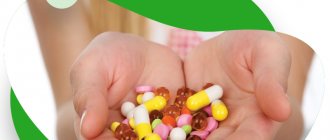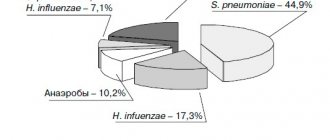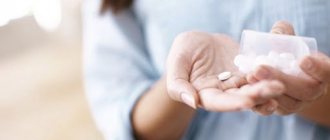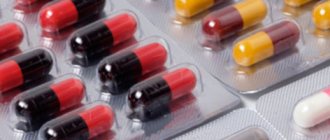Almost 80 years ago, in February 1941, British doctors injected penicillin into a sick person for the first time. Thus began a new era in the history of medicine - the era of antibiotics. Their discovery allowed humanity to cope with many previously considered fatal diseases, and average life expectancy has since increased by 25 years. But even in our time, there are many misconceptions among people about this important class of drugs. As surveys show, even pharmacists are no exception1. In this material, we answered the main questions that pharmacy visitors may have in connection with antibiotic treatment.
Do antibiotics help with colds and flu?
No, because most colds, including influenza and acute respiratory viral infections, are caused by viruses, and antibiotics were created to fight bacteria. This is a completely different type of pathogen, and it is naive to expect that the same drugs will cope with both of them - the viral infection will continue to develop.
By the way, for the same reason, antibiotics are useless in the treatment of fungal infections (nail fungus, ringworm, etc.). Misconceptions about the effectiveness of antibiotics in the fight against colds are still widespread. A WHO survey conducted in 12 countries (including Russia) showed that two-thirds of respondents were confident in this2.
Antibiotic therapy
Treatment with antibiotics is carried out according to certain schemes and principles. The first thing to understand is that usually a bacterial infection requires immediate initiation of therapy. This is especially true for acute diseases such as:
- Pneumonia and other diseases of the lower respiratory tract.
- Bacterial meningitis.
- Otitis.
- Tonsillitis and sore throat.
- Sinusitis.
- Pyelonephritis.
In addition, antibiotic therapy begins immediately after surgical treatment, for severe burns, injuries, and frostbite.
Antibacterial treatment will be most effective when the pathogen is precisely known. For this purpose, bacterial seeding of biological fluids is carried out.
Is it possible to buy antibiotics without a doctor's prescription?
No. Most antibiotics today are available by prescription—and for good reason. One of the main reasons for this was the generally recognized problem of the development of bacterial resistance to existing drugs. Like all living things, during evolution microorganisms adapt to environmental conditions. Therefore, some time after the invention of antibiotics, scientists noticed that these substances were no longer as effective3 as before. That is why humanity is constantly searching for new antibacterial agents.
It is impossible to stop the evolution of bacteria, but resistance would develop more slowly if people did not use antibiotics uncontrollably, thereby “training” microorganisms and helping them develop immunity to drugs. Today, bacteria are already known that are not susceptible to most antibiotics. And in 2021, American doctors documented the death of a patient from pneumonia, the causative agent of which turned out to be resistant to all drugs used in the United States.
The situation is complicated by the fact that the search for new antibiotics has been very difficult in recent decades. Therefore, scientists fear that someday humanity will once again find itself unarmed in the face of diseases long defeated. And that is why taking antibiotics without a doctor’s prescription is extremely undesirable.
Bakposev
Bacterial culture is the decisive analysis in identifying the causative agent of the disease. The biological fluid is placed on special nutrient media and then the growth of the cultures is examined.
In addition to identifying bacteria or fungi, their sensitivity to various antibacterial and antimycotic drugs is also analyzed.
This allows you to select exactly the drug or group of drugs to which the microbe is most sensitive, and helps to avoid the formation of drug resistance.
If the drug is selected based on the antibiogram data, it usually does not require replacement during treatment.
However, despite its accessibility and information content, bacterial sowing is not without its drawbacks. This analysis usually takes some time to complete. Most often, the growth of bacterial cultures occurs within 5–7 days. And it is precisely this factor that does not allow the use of bacterial culture in the routine prescription of antibiotics. And the selection of a drug for the treatment of infections is carried out empirically.
How harmful are antibiotics?
Like all drugs, antibacterial drugs have their side effects. The gastrointestinal tract takes the first blow: antibiotics can destroy beneficial intestinal microflora and cause dysbacteriosis, diarrhea, and colitis5. Some drugs in this group can also cause liver dysfunction6, cholestatic jaundice, hepatitis, nephritis, and allergic reactions7.
But don’t panic: according to statistics, side effects from taking these drugs are quite rare. Thus, researchers from the Omsk region, where almost 2 million people live, recorded only 231 such cases from 2005 to 20117. If you take antibiotics as prescribed by your doctor and strictly follow his recommendations, the risk of harming yourself will be minimal. With uncontrolled drug use, it is, of course, higher.
And it still sounds threatening. Is it possible to replace antibiotics with natural remedies or dietary supplements?
Humanity certainly owes the appearance of the first antibiotics to nature. Already in ancient Egypt, people applied moldy bread to infected wounds. But it is unlikely that any of our compatriots will dare to repeat this in the 21st century. As for dietary supplements with a claimed antibacterial effect, according to the law they, like all dietary supplements in general, are not medicines. Despite the fact that they are sold in pharmacies, their production and circulation are regulated by the Law on Food Quality and Safety.
Thus, dietary supplements cannot be used to treat diseases and rather perform a supportive function. Yes, for mild colds, inflammation of the mucous membranes and skin, you can try to supplement the action of antibiotics with natural antiseptics, but they will not be able to cure salmonellosis or pneumonia.
But I still don't want to take antibiotics for too long. Is it possible to stop when it gets better?
The position of official medicine today is that it is impossible to stop the course of antibiotics immediately after the symptoms disappear8. This way you can harm yourself and help the infection. By stopping antibiotics ahead of schedule, a person risks leaving the disease “unfinished.” Then the strongest bacteria will become resistant to the medicine used, and the disease may become latent.
However, not all scientists share this point of view. In 2021, English doctors published an article calling for a review of current practice. The researchers say the link between early antibiotic withdrawal and the development of bacterial resistance has not been conclusively proven and insist that the course of treatment should be as short as possible. According to them, resistance in bacteria develops precisely with prolonged exposure to drugs.
However, the WHO’s opinion on this issue has not yet changed: no matter how long the course of antibiotics is, it must be completed.
Replacement timing
According to the protocols, the effectiveness of antibiotics is assessed after 72 hours, or three days. In some cases (in severe forms), the medication is replaced after 48 hours.
If, before treatment, biological fluids were taken from the patient for bacterial culture, and the results indicate that the pathogen is resistant to the treatment, the antibiotic can be replaced immediately. In this situation, the doctor does not have to make a choice. He prescribes the drug to which the microbe is most sensitive. Naturally, the patient’s concomitant diseases and possible allergies are taken into account.
But if bacterial culture was not carried out, antibiotic replacement is also carried out empirically. In this regard, in severe illnesses, doctors tend to draw blood or other fluids before starting antibiotic therapy and send them for analysis. In the future, if there is a need to replace the drug, this can already be done taking into account the certain sensitivity of the pathogen.
How do antibiotics combine with other medications?
There are a lot of antibiotics, and each of them interacts with other medications in its own way, so it is better to read the instructions before purchasing. This should not be neglected, because certain combinations of drugs can lead to serious negative consequences. For example, some antibiotics should not be used simultaneously with NSAIDs - this can lead to the development of seizures9. Combining other antibacterial drugs with antihistamines can cause serious heart complications, including death9. The combination of a number of drugs with oral contraceptives is also unsafe - their simultaneous use can cause jaundice9. Even the combined use of two antibiotics from different groups can cause harm to human health. This is why it is especially important to take medications as prescribed by your doctor, and not based on your own considerations.
Changing medication
Replacing the antibacterial drug is quite acceptable during the treatment process. If a doctor prescribes one medicine first and then another, this does not indicate his unprofessionalism.
Sometimes patients are perplexed why treatment is started without taking into account the sensitivity of the microbe to drugs. But unfortunately, the loss of time required to carry out the analysis can result in serious complications for the patient.
Even ordinary inflammation of the paranasal sinuses or tonsils can progress very quickly in the absence of timely treatment. If we are talking about severe pneumonia or meningitis, not only days, but also hours are important, and delaying therapy is unacceptable.
That is why doctors first prescribe therapy according to the protocol, and then adjust it according to clinical manifestations and laboratory examination data.
However, replacement of an antibacterial drug should be carried out according to certain principles.
Are cheap analogues as effective as expensive antibiotics?
Yes and no. On the one hand, high-quality generics of well-known drugs are indeed in no way inferior to them. But, on the other hand, there are also plenty of not very good analogues on the market. Research by Russian scientists has shown that in a number of generics the concentration of active substances is noticeably lower than in the original drug14. Such drugs can not only reduce the effectiveness of treatment, but also help microbes develop resistance to all drugs in this class. According to WHO, antibiotics are most often the target of adulteration by unscrupulous manufacturers in developing countries15.
Can I drink alcohol while taking antibiotics?
Not all antibiotics interact with alcohol, but doctors still recommend refraining from drinking during treatment. A number of antibacterial drugs are completely incompatible with alcohol. For example, metronidazole, tinidazole, sulfamethoxazole, trimethoprim and some cephalosporins16.
The interaction of antibiotics with alcohol causes a number of unpleasant symptoms in a person: vomiting, diarrhea, tachycardia, dizziness, confusion, etc. It is not surprising that the same metronidazole is widely used to treat alcoholism. Doxycycline also has a very bad effect on chronic alcoholics (as well as people with liver damage).
Alcohol is also contraindicated when taking linezolid - their interaction can lead to a jump in blood pressure.
At the same time, it is believed that most other antibiotics do not interact with alcohol in any way. However, it is worth understanding that we are only talking about maintaining the effectiveness of these drugs themselves. No one has yet conducted serious research on the possible harm of taking antibiotics and alcohol together. Therefore, doctors continue to insist that it is better not to drink alcohol while taking these drugs. The effect of combining antibiotics with alcohol can be unpredictable, because alcohol disrupts normal metabolism, increases blood sugar, suppresses the immune system, and negatively affects the nervous system and liver. These negative consequences may coincide with the side effects of the antibiotics themselves, and then the overall harm to the body will increase significantly.
Choosing a second drug
If after 72 hours the patient has no positive dynamics, the fever persists, and the condition worsens, the doctor stops the antibiotic and prescribes another medicine. As a rule, blood tests are taken at this time, which can also show confirmation of the ineffectiveness of the first medicine. In such a situation, there is an increased level of leukocytes in the blood and a shift of the formula to the left (an increase in the number of band neutrophils).
When choosing a second antibiotic, one is guided by its spectrum of action. If the first drug acted mostly on gram-positive microorganisms, then gram-negative microflora should predominate in the sensitivity zone of the second antibiotic.
Most often, treatment of bacterial infections begins with broad-spectrum drugs. In this case, if it is ineffective, most likely we are talking about intracellular microorganisms - chlamydia, mycoplasma. They are affected by special medications called macrolides.
In addition, sometimes the microbes themselves are perfectly protected from the action of antibiotics. They can destroy them using special enzymes - for example, beta-lactamases.
This often happens with previously popular penicillin drugs.
And although the microbe is sensitive to the active substance, the latter cannot harm it. In such a situation, it would be appropriate to select an antibiotic with a similar spectrum of action, but resistant to the action of bacterial enzymes.
Fluoroquinolones are a good alternative. They are rarely prescribed as first-line therapy due to frequent side effects. But their wide spectrum of action makes it possible to cope with most infections when other drugs are ineffective.
Should you have antibiotics in your home medicine cabinet?
You should not store antibiotics in home medicine cabinets. Medicines that helped you once will not necessarily help you the next time. Even if the symptoms of the disease are similar. Only a doctor should prescribe treatment in each specific case.
The World Health Organization also calls not to use leftovers of previously prescribed medications and not to share antibiotics with other people17. Violation of this prohibition, according to WHO, contributes to the development of resistance in bacteria.
Sources
- Popadyuk L.A., Reshetko O.V., Ardentova N.N. Analysis of knowledge of pharmacy workers on the use of antibacterial drugs // https://cyberleninka.ru/article/n/analiz-znanii-rabotnikov-aptek-po-primeneniyu-antibakterialnyh-pre…
- WHO. WHO country survey reveals widespread public misunderstanding of antibiotic resistance // https://www.who.int/ru/news-room/detail/16-11-2015-who-multi-country-survey-reveals-widespread -publish...
- US centers for disease control and prevention. About antibiotic resistance // https://www.cdc.gov/drugresistance/about.html
- Lei Chen, Randal Todd and al. Notes from the Field: Pan-Resistant New Delhi Metallo-Beta-Lactamase-Producing Klebsiella pneumoniae - Washoe County, Nevada, 2021 // https://www.cdc.gov/mmwr/volumes/66/wr/mm6601a7.htm
- Usenko D.V. The influence of antibiotics and probiotics on the gastrointestinal microbiome // https://cyberleninka.ru/article/n/vliyanie-antibiotikov-i-probiotikov-na-mikrobiom-zheludochno-kishe…
- Anne M Larson. Drug-induced liver injury // https://www.uptodate.com/contents/drug-induced-liver-injury#H156226750
- Churina O.S., Shukil L.V. Characteristics of side effects of antibacterial drugs // https://cyberleninka.ru/article/n/harakteristika-pobochnyh-deystviy-antibakterialnyh-preparatov/view…
- WHO. Does an incomplete course of antibiotics lead to the development of antibiotic resistance? // https://cyberleninka.ru/article/n/harakteristika-pobochnyh-deystviy-antibakterialnyh-preparatov/view…
- Asetskaya I.L. Interaction of antibiotics with drugs of other medicinal groups // https://cyberleninka.ru/article/n/vzaimodeystvie-antibiotikov-s-preparatami-drugih-lekarstvennyh-gru…
- Susanne Hempel and al. Probiotics for the prevention and treatment of antibiotic-associated diarrhea: a systematic review and meta-analysis // https://pubmed.ncbi.nlm.nih.gov/22570464/
- Jotham Suez et al. Post-Antibiotic Gut Mucosal Microbiome Reconstitution Is Impaired by Probiotics and Improved by Autologous FMT // https://www.cell.com/cell/fulltext/S0092-8674(18)31108-5?_returnURL=https%3A%2F% 2Flinkinghub.elsevie…
- Sizentsov A.N. and others. Evaluation of the effectiveness of the combined use of antibiotics and probiotics in vitro // https://www.science-education.ru/ru/article/view?id=26374
- Stetsyuk O.U., Andreeva I.V. Popular myths and misconceptions regarding antibiotics among practicing doctors // https://www.rmj.ru/articles/antibiotiki/Populyarnye_mify_i_zablughdeniya_otnositelyno_antibiotikov_s…
- Journal "Russian Otorhinolaryngology", No. 4 (83), 2021, pp. 121-123. Resistance of respiratory microorganisms to antibiotics in modern conditions: expert opinion // https://entru.org/files/preview/2016/04/j_rus_LOR_4_2016.pdf
- WHO. 1 in 10 medical products in developing countries is substandard or falsified // https://www.who.int/en/news-room/detail/28-11-2017-1-in-10-medical-products-in- developing-countries-…
- James M. Steckelberg. What are the effects of drinking alcohol while taking antibiotics? // https://www.mayoclinic.org/healthy-lifestyle/consumer-health/expert-answers/antibiotics-and-alcohol/…
- WHO. Antibiotic resistance is a serious threat to public health // https://www.who.int/mediacentre/news/releases/2014/amr-report/ru/








